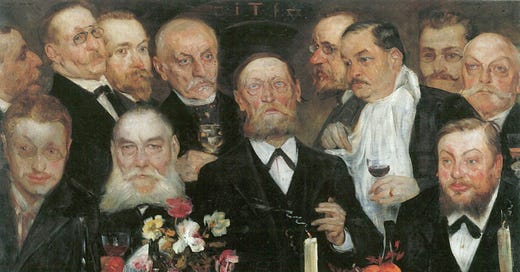“Die Logenbrüder” or The Lodge Brothers was painted by German artist and Freemason, Lovis Corinth between 1898 and 1899 but has been know by many different names over the years, originally “Der Trinkspruch in der Loge In Treue fest” (Toast in the Lodge “In Treue fest”) before “Die Logenbrüder” (The Lodge Brothers) and latterly “Firm in loyalty”.
Lovis Corinth (Born: 1858 Died: 1925), whose real name is Franz Heinrich Louis Corinth, was a German painter, graphics artist and printmaker, and is often described as one of the most important representatives of German Impressionism and Expressionism and today is regarded as one of the ‘Classics of Modern Art’.
Born in Tapiau in East Prussia, Corinth was the son of a tanner. He displayed a talent for drawing at a young age and went on to study art at the academy of Königsberg in 1876 before attending the Academy of Fine Art in Munich four years later and at the time, rivalled Paris as the avant-garde art centre of Europe. His studies were interrupted however in 1883 by the so called “one-year volunteer” requirement of Military Service.
In his lifetime Corinth's created more than 130 paintings, many more drawings in an almost “cartoonist style” and wrote several books and essays on art and painting. Although he had previously painted portraits for friends and family, “The Lodge Brothers” may be his earliest example of an actual commission.
Lovis Corinth The Freemason
Bro. Lovis Corinth joined Johannis-Loge “Immanuel” in Königsberg during 1890 and after 6 years moved to Munich where he was a founding member of Johannis-Lodge “In Treue fest” (the Lodge featured in the painting), registering as a Brother Fellow Craft and later being raised to that of Master Mason on 16th October 1896. Holding the office of Deputy Master of Ceremonies in 1897/1898 and then appointed Master of Ceremonies in 1899.
The Lodges first accommodation was within the Isarlust restaurant, however after just a year, moved to a house in Gabelsberger Straße, Munich due to a lack of space and steadily increasing membership. Corinth also set up his apartment and studio directly above the Lodge rooms.
The painting, now held by Städtische Galerie im Lenbachhaus in Munich, is oil on canvas and depicts 12 brethren of Johannis-Lodge “In Treue fest” with the Master of the Lodge Brother Buhm taking up the central position in the scene.
The other Brethren of the lodge in the lower row are Johannes Hering (businessman) and Eduard Siehr (first lieutenant) on the left, followed by Carl Schnürpel (insurance director), who as master of ceremonies and likely Corinth’s predecessor in this position. On the far right Dr. Paul Heyn (doctor) and Richard Rintfleisch (general agent). In the top row from left to right are Dr. Eduard Hauch (dentist), Conrad Müller (insurance director), Paul Schellinsky (insurance director), Carl Taetzel (retiree), Dr. Carl Ladisch (chemist), Otto Hofmann (bookseller) and Julius Gramm (chief inspector). Judging by their sweaty skin and rosey red noses and cheeks it’s clear Corinth was portraying them in an already intoxicated state.
Corinth started the painting in the April of 1898 however it wasn’t completed until the June of the following year. There is also a preliminary drawing with watercolour in the Lenbachhaus which bears the date 1897 and resembles the final composition closely with the exception being that it only depicts 9 members of the Lodge.
Corinth’s orientation towards Dutch art of the 16th Century is well documented, and he was heavily influenced by Dutch artists Rembrandt, Hals and Rubens, the painting is based on an earlier work of Rembrandt.
Dutch group portraits of this type commonly the place the crest of the guild or a tablet with the names of the persons represented above the head of the central figure. These are known as “Doelenstück” (also called “Schützenstück”).
Corinth has also utilised this device in the empty space above the head of the Master with the letters “I T F” which stands for “in Treue fest” or “firm in faithfulness / firm in fidelity” which is the motto and name of the Lodge however is often translated as “firm in loyalty” and used as an alternative name for the painting. These are flanked by a square to the left and the six-pointed Seal of Solomon to the right.
Freemasonry clearly influenced the works of Corinth and he created a series illustrations of works that were in the Lodge’s possession to be added to an essay entitled “Freemasonry. The Brotherhood”. Between 1900 and 1919 he painted portraits of Masters of “In Treue fest” including Bro. Conrad Müller (1900), Bro. Von Zöllner (1906) and Bro. Fritz Thieme (1919). Another examples would be his work Self-Portrait with Skeleton (1896).
Ironically the 9 years that Corinth spent in Munich, the period in which this painting was completed, were not his most productive. In fact he was known more for his ability to drink copious amounts of wine and champagne - perhaps the influence of his Lodge brethren looking at the table in the painting.
Thanks go to Carsten Rinne of the “Art and The Craft” group on Facebook for providing some additional information to the original post that unlocked more research and permitted me to update this article.





